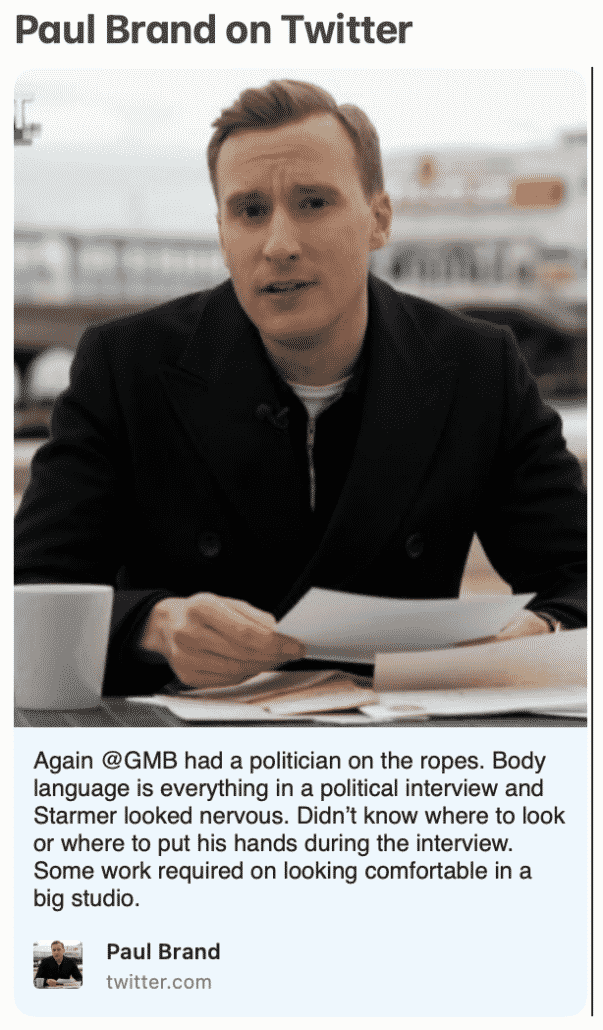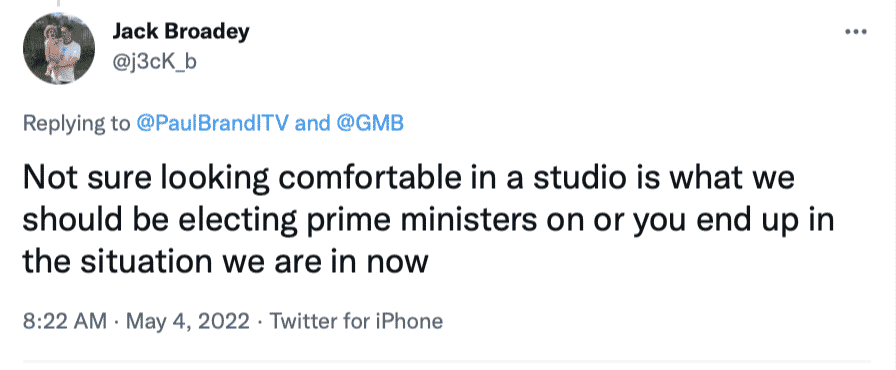Not a Good Look for Someone Who Wants to be PM
Paul Brand pointed out on Twitter last week what was obvious to any viewer. The leader of the opposition looked very uncomfortable in his set-piece interview on Good Morning Britain. You might even say scared.
It is not a good look for someone who wants to be Prime Minister.
On this occasion he was being interviewed by the GMB duo of Richard Madeley and Susanna Reid. Reid positions herself as a tough aggressive journalist and she has clearly put a lot of thought into how to be an intimidating interviewer. The BBC no longer allows disrespectful aggression and will publicly and privately criticise presenters who step over the line as Nick Robinson did with the Prime Minister last year, but other broadcasters still encourage some interviewers to make this style part of the brand.
Others on Twitter were irritated by such superficial analysis of Sir Keir Starmer’s performance.
At The Media Coach, we do think body language matters and on TV it can – as it does here – undermine the message.
If you listen to Starmer in this interview without watching the footage, what he says is strong, clear and credible. He doesn’t sound as if he is struggling to cope with the aggression or the questions.
But if you watch you have a totally different impression.
What is strange is that Starmer has not already been coached out of looking rattled. Given his job and his ambition you would think some work would have gone into this.
As someone who coaches people to look comfortable on TV (among many other things) I would say it is not particularly difficult to tackle and simple coaching techniques are pretty consistently effective.
How you behave on camera when being ‘grilled’ by a journalist is no different to any other unconscious behaviour. You cannot change it until it becomes conscious. And then you need a feedback loop so you can constantly ‘improve’ and get to where you want to be.
In training we use the video camera, record an interview, play it back and identify the unwanted behaviour, then suggest alternatives. Trying these different things out on camera then watching it back can fairly quickly produce behaviour change. Clearly, this has to be ‘topped up’ at regular intervals but if you are always appearing on the media that is not a problem. You can ensure each event is recorded and watch some of them back.
Media interviews (and presentations) are a performance. As soon as you realise this you can apply a whole range of tools and techniques honed by actors and broadcasters. Slow down. Speed up. Drop your shoulders. Breath differently. Pretend you like the person interviewing you, etc.
My colleague, Eric Dixon, says your audience needs to ‘Believe, Like and Trust’ you – giving the acronym BLT, just like the sandwich. I look for ‘Warmth, Authority and Animation’ which is a less elegant acronym but works better for me in training.
I know of a number of politicians and others who fought against media training (Jeremy Corbyn was one apparently) and who rather too late in the day embraced it out of necessity. London is full of great media trainers, someone should persuade Starmer to invest. If it’s not too late.
- What Crisis Spokespeople Can Learn from the Huntingdon Train Statement - November 5, 2025
- Waitrose Shows the Perils of Being Tone-Deaf in the Social Media Age - October 29, 2025
- A New Dawn (Again): Why Clichés Still Make Great Headlines - October 22, 2025






Lindsay’s right: body language matters. To those on Twitter who say it’s not the factor you should be electing Prime Ministers on – the truth is, it’s about the whole package. Of course, substance is key. But without the style to carry it off, the danger is that you won’t persuade enough people to BLT – Believe, Like and Trust you.